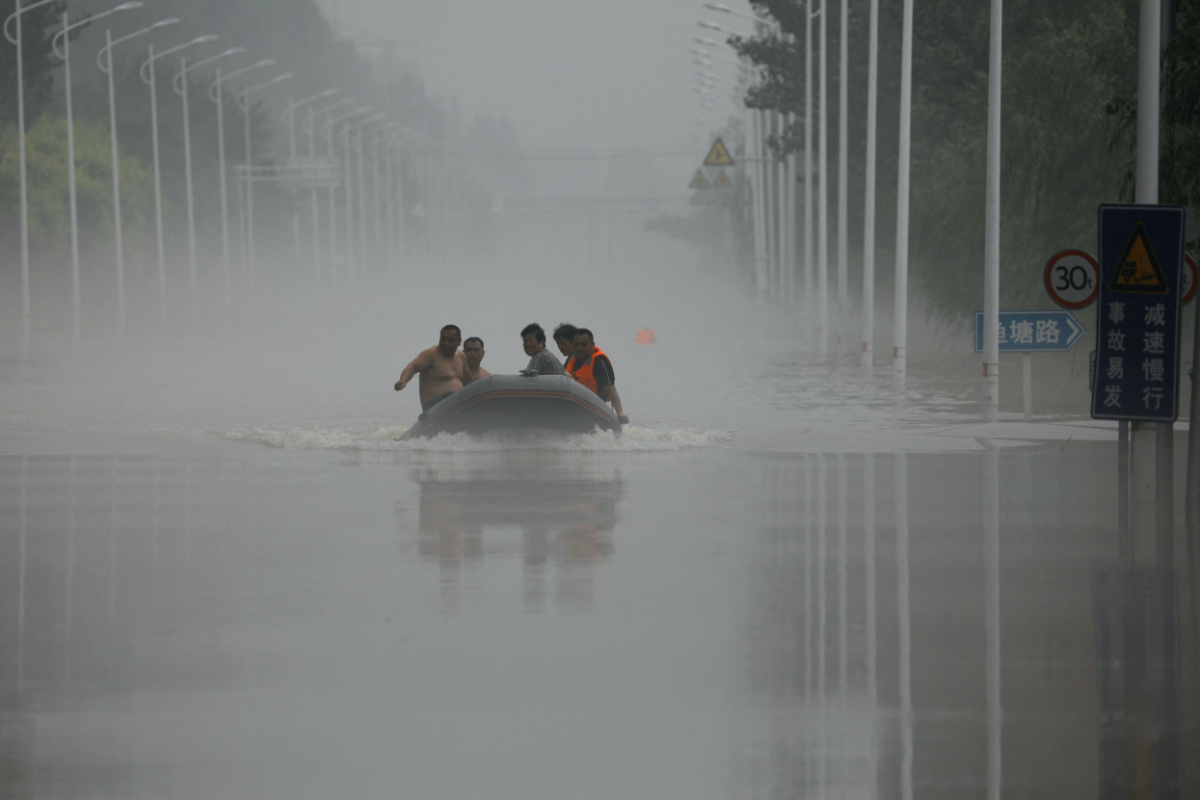Shenzhen, China
Reuters
Floodwaters from Typhoon Doksuri continued to deluge farms and cities in northeast China on Saturday, while authorities in other parts of the country struggled to deal with the aftermath of one of the strongest storms in years.
Almost 15,000 residents were moved out of the city of Shulan in corn-growing Jilin province, where one person died and four were missing, according to state media.

People ride a boat through a flooded road after the rains and floods brought by remnants of Typhoon Doksuri, in Zhuozhou, Hebei province, China, on 3rd August, 2023. PICTURE: Reuters/Tingshu Wang/File photo
Rain has fallen continuously in Shulan since 1st August, with some areas getting 489 mm, five times the previous record. Bridges collapsed and roads were damaged across the city, state media reported.
State news agency China News Service showed images of waterlogged streets around factories and homes in Shulan, a city of more than 700,000.
The impact of typhoons is rare in China’s north-east, with most typhoons moving west or north-west after making landfall, meteorological experts say.
The record-breaking rains arrived in late July as the remnants of Typhoon Doksuri moved inland, battering northern China and causing massive floods, disrupting the lives of millions.
Around 1.54 million people had been evacuated from at-risk areas in north China’s Hebei province as of Saturday morning, Xinhua reported.
Authorities in Beijing on Saturday warned of sinkholes and mudslides in the Fangshan and Mentougou outer districts of the capital.
Rainfall this past week broke many records in Beijing and northern China, with the vast Haihe river basin hit with its worst flooding since 1963.
Floodwaters could take up to a month to recede in Hebei province, a water resources department official told state media.
China has long been aware of urban waterlogging risks, with rapid development creating metropolitan sprawls that cover flood plains with concrete. Extreme weather driven by global warming is making it worse.
On Saturday, water levels in Zhuozhou to the southwest of Beijing began to drop, with search and rescue and flood drainage efforts continuing in Hebei province’s hardest-hit city, according to state media.
Around 100,000 people – a sixth of its population – have been evacuated.
We rely on our readers to fund Sight's work - become a financial supporter today!
For more information, head to our Subscriber's page.
In Baoding prefecture, to which Zhuozhou belongs, record rainfall led to the overflow of 67 of its 83 smaller reservoirs, the collapse of more than 4,000 houses and the death of at least 10 people, the Baoding government said on Saturday.
Nearly 300 bridges and over 550 kilometres of rural roads have been damaged by water, the government said, with Baoding’s direct economic losses reaching nearly 17 billion yuan ($US2.4 billion) as of Saturday.
In July, China’s direct economic losses from natural disasters surged to 41.18 billion yuan ($US5.74 billion), more than the total for the previous six months, after two powerful typhoons during the month.
On Saturday authorities of Bazhou city in Hebei expressed “heartfelt thanks” to residents for evacuating their homes in an area where floodwaters had been diverted for storage, and said a review for disaster compensation for damaged agricultural production and housing would take place when the flood recedes.






